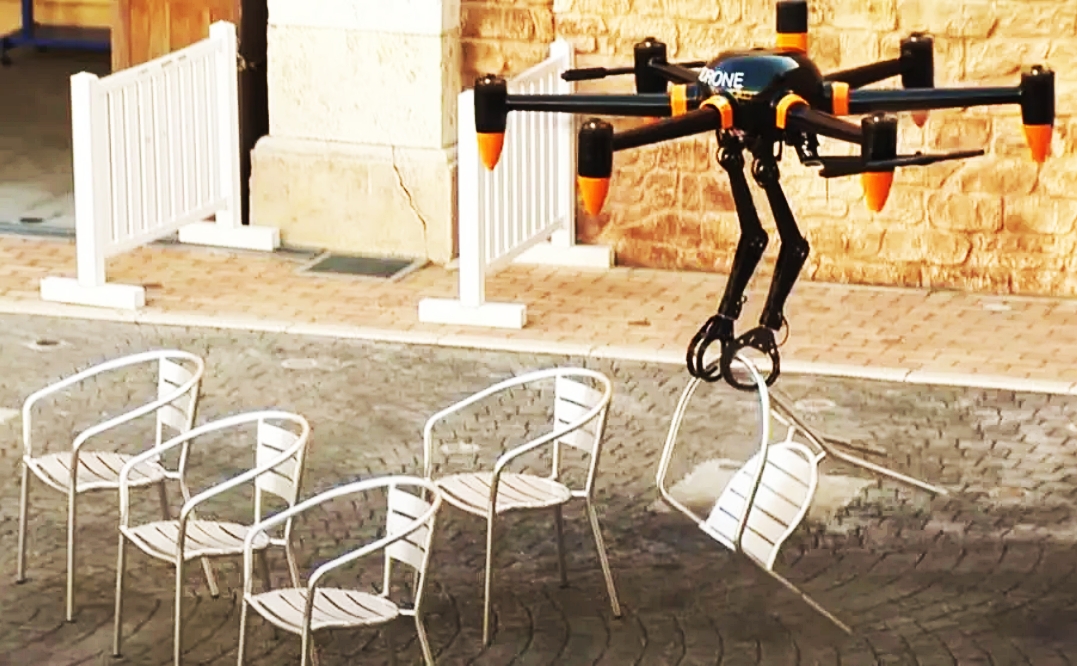Ukrainian troops have recently had some good results with drone rescues, and have also been able to grab Russian drones, weapons and radios from the battlefield.
Daring Drone Rescues
Hobbyists tend to lose drones when they get too ambitious. Rescues often involve a ladder, a long stick, or a difficult climb. When the drone ends up somewhere too high to reach, the need to recover a gadget costing several hundred dollars (or more) can prompt more creative solutions.
Drone operators can even buy a Tarot Mantis Claw Grabber Drone Recovery Hook, a nifty unpowered device made or carbon fiber with six articulated claws. When lowered over a fallen drone, the claws close and take hold simply from gravity. Judging from this video, it appears to be a practical tool for drone retrieval, at least if the subject is on a flattish surface:
One flaw with many of these solutions is the lack of a release mechanism. If the lost drone is stuck in place, or too heavy to lift, then the recovery drone may be lost too.

This Prodrone multicopter is equipped with dual gripping claws to pick up items from the ground PRODRONE
Some industrial drones are equipped with purpose-build gripping claws and can pick up larger objects weighing several pounds, like this Japanese Prodrone. They would be ideal for small drone rescues, but way too expensive for consumers.
Unharmed But Unreachable
The situation is somewhat different in Ukraine. While there are some accidents, the biggest cause of drone loss is jamming. Typically, a quadcopter that loses radio connection with its operator will try to fly back to where it last connected. If it cannot do this, it will make a soft landing wherever it is. Widespread jamming and spoofing by electronic warfare systems means that many drones simply drop out of the sky and land undamaged but in inaccessible places.
Defensive positions on both sides are protected by extensive minefields, and drones may land in one of these, or in a place covered by enemy fire.
In 2023 the thinktank RUSI claimed that Ukraine was losing 10,000 drones a month, mainly to jamming. The figure is contested, but it gives an idea of the scale of the problem.
Ukrainian operators, especially those with previous drone experience, soon found ways to recover their quadcopters. In December 2022 a video on social media called ‘Saving Private Mavic’ showed a successful drone recovery mission.
Since then there have been some more systematic efforts.
Every Drone Counts
This month Ukrainian news source Euromaidan Press reported on the 128th Separate Mountain Assault Brigade drone reconnaissance unit recovered fallen drones. As always they never have enough drones for their needs, and every drone counts.
“Retrieving drones on foot was not an option because it contradicts their purpose—preserving lives. So, we decided to find a way to evacuate our drones,”
the unit commander told Euromaidan.
Their first efforts failed because of the release mechanism problem, but the unit went on to develop a triple hook device with hooks made from grenade rings, likely left over from drone bombing missions which often drop hand grenades. They eventually succeeded in picking up a drone from the middle of a minefield 500 meters from their position. But getting back was not as easy as expected.
“Flying with such weight was very challenging, as the wind and inertia swayed the rescued drone in all directions. We managed to secure it and had to land on the way back, but by then it had reached a safe place,” says the commander.
They set about picking up all the known drone losses in the area. Some were too difficult to lift and the rescue drone had to disengage, but the unit succeeded in rescuing 16 drones, 10 of them still in flyable condition. The six damaged drones were sent back for repair.
The unit is continuing to develop their recovery system and working out new ways to retrieve fallen drones from the battlefield.
Grabbing Trophies
Russia also loses large numbers of drones. These are also fair game for recovery, although some have been found to be booby-trapped with devices that cause them to explode after a time delay if disturbed.
Videos shared online show Ukrainian drones picking up fallen Russian quadcopters, and there are also more ambitious operations. Last year a Baba Yaga heavy bomber retrieved a downed Russian Orlan-10 reconnaissance drone, a prize worth over $100,000.
Another intelligence-led operation led to a DJI Mavic 3 picking up an encrypted Russian radio used in a failed assault, apparently with magnet fishing. According to the unit involved, they were then able to listen in to Russian communications for several days and ambush attacking forces.
A recent BBC report on the Peaky Blinders drone unit suggests that battlefield retrieval is a hobby for drone operators when they have nothing else to do. The report describes how a drone with a grappling hook picked up an assault rifle from a dead Russian soldier. The standard AK-12 rifle weighs over seven pounds, so the job required a bigger drone than the usual Mavic. It is surprising they would spend the effort on such a low-value item, but perhaps they were looking for something else.
It seems that Baba Yaga heavy multicopters really are sent out to prowl spots where Russian assaults have been halted. This may be the source of the persistent Russian wartime myth that Baba Yagas equipped with claws come to carry away wounded Russian soldiers.
This type of drone warfare is still evolving. Clearly, just as drones can now drop unexpected items, such as spiked caltrops to puncture tires, they can also pick them up. Commercial drone technology has now evolved to the stage where AI-guided drones can find and identify ripe apples and pick them autonomously. Expect to see a lot more creative drone applications in the coming months.
UPDATE 31st May: In response to the above, I had this confirmation that Ukrainian forces are using customer-made drone recovery claws


